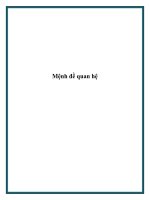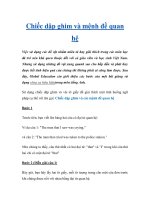Rút gọn mệnh đề quan hệ
Bạn đang xem bản rút gọn của tài liệu. Xem và tải ngay bản đầy đủ của tài liệu tại đây (82.52 KB, 4 trang )
Mệnh đề (Clause) là một phần của câu, nó có thể bao gồm nhiều từ hay có cấu
trúc của cả một câu. Mệnh đề quan hệ dùng để giải thích rõ hơn về danh từ đứng
trước nó. Dưới đây là các cách rút gọn và bài tập rút gọn mệnh đề quan hệ có đáp
án đầy đủ và chính xác nhất.
Các cách rút gọn mệnh đề quan hệ trong tiếng anh
Có 6 cách rút gọn câu dùng mệnh đề quan hệ trong tiếng anh.
1. Rút gọn mệnh đề quan hệ bằng cách dùng participle phrases (V-ing
phrase)
Nếu động từ trong mệnh đề quan hệ ở thể chủ động (active), ta dùng cụm hiện
tại phân từ (present participle phrase) thay cho mệnh đề đó. Thao tác: Bỏ đại từ
quan hệ và trợ động từ, đưa động từ chính về nguyên mẫu và thêm đuôi – ing.
Ex: The man who is standing there is my brother => The man standing there is my
brother
Do you know the boy who broke the windows last night? => Do you know the boy
breaking the windows last night?
2. Rút gọn bằng cách dùng past participle phrase (V-ed phrase)
Nếu động từ trong mệnh đề quan hệ ở thể bị động (passive) ta dùng cụm quá khứ
phân từ (past participle phrase).
Ex: The books which were written by Nam Cao are interesting => The books
written by Nam Cao are interesting.
The students who were punished by teacher are lazy =>The students punished by
teacher are lazy.
3. Rút gọn mệnh đề quan hệ bằng to infinitive
Dùng khi danh từ đứng trước có các chữ sau đây bổ nghĩa: the only, the first, the
second,… the last, so sánh nhất, mục đích.
Ex: Tom is the last person who enters the room = Tom is the last person to enter
the room.
John is the youngest person who takes part in the race =>John is the youngest
person to take part in the race.
Động từ là HAVE/HAD
Ex: I have much homework that I must do => I have many homework to do.
Đầu câu có HERE (BE), THERE (BE)
Ex: There are six letters which have to be written today => There are six letters to
be written today.
4. Rút gọn mệnh đề quan hệ dùng cụm danh từ (đồng cách danh từ)
Dùng khi mệnh đề quan hệ tình từ có dạng: S + BE + DANH TỪ /CỤM DANH
TỪ/CỤM GIỚI TỪ Cách làm: bỏ who ,which và be.
Ex: Football, which is a popular sport, is very good for health => Football, a
popular sport, is very good for health.
Do you like the book which is on the table? => Do you like the book on the table?
5. Mệnh đề rút gọn tính từ có dạng be và tính từ/cụm tính từ
Có 2 công thức rút gọn:
Công thức 1: Bỏ who, which…to be -> giữ nguyên tính từ phía sau.
Điều kiện 1: Nếu phía trước that là đại từ phiếm chỉ như something, anything,
anybody…
Ex: There must be something that is wrong => There must be something wrong.
Điều kiện 2: Có dấu phẩy phía trước và phải có từ 2 tính từ trở lên.
Ex: My grandmother, who is old and sick, never goes out of the house => My
grandmother, old and sick, never goes out of the house.
Công thức 2: Những trường hợp còn lại ta đem tính từ lên trước danh từ.
Ex: My grandmother, who is sick, never goes out of the house => My sick
grandmother never goes out of the house.
I buy a hat which is very beautiful and fashionable => I buy a very beautiful and
fashionable hat.
Tuy nhiên nếu cụm tính từ gồm cả danh từ ở trong nó thì ta chỉ còn cách dùng Ving mà thôi.
Ex: I met a man who was very good at both English and French => I met a man
being very good at both English and French.
Tóm lại cách rút gọn loại này khá phức tạp vì nó tùy thuộc vào đến 3 yếu tố: có
một hay nhiều tính từ – danh từ đứng trước có phải là phiếm chỉ không có dấu
phẩy hay không
6. Mệnh đề tính từ thành tính từ ghép
Cách làm: Ta sẽ rút gọn mệnh đề thành một tính từ ghép bằng cách tìm trong
mệnh đề một số đếm và danh từ đi sau nó, sau đó ta để chúng kế nhau và thêm
dấu gạch nối ở giữa. Đem tính từ ghép đó ra trước danh từ đứng truớc who,
which…- những phần còn lại bỏ hết.
Lưu ý:
+ Danh từ không được thêm “s”
+ Chỉ dùng được dạng này khi mệnh để tính từ có số đếm
+ Các cụm như tuổi thì sẽ viết lại cả 3 từ và gạch nối giữa chúng (two years old à
two-year-old)
Ex: I have a car which has four seats => I have a four-seat car. I had a holiday
which lasted two days => I had a two-day holiday.
1. The man who is standing there is a clown.
2. The envelop which lies on the table has no stamp on it.
3. Benzene, which was discovered by Faraday, became the starting point in the
manufacture of many dyes, perfumes and explosives.
4. My grandmother, who is old and sick, never goes out of the house.
5. The student don't know how to do exercise which were given by the teacher
yesterday.
6. The diagrams which were made by young Faraday were sent to Sir Humphry
Davy at the end of 1812.
7. The gentleman who lives next door to me is a well-known orator.
8. All the astronauts who are orbiting the earth in space capsules are weightless.
9. All students don't hand in their papers will fail in the exam.
10. I saw many houses that were destroyed by the storm.
11. The street which leads to the school is very wide.
12. The system which is used here is very successful.
13. John, who teaches my son, is my neighbor.
14. The candidates who are sitting for the exam are all from Vietnam.
15. We are driving on the road which was built in 1980.
16. Customers who complain about the service should see the manager.
17. The city which was destroyed during the war has now been rebuilt.
18. My brother, who met you yesterday, works for a big firm.
19. The vegetable which are sold in this shop are grown without chemicals.









